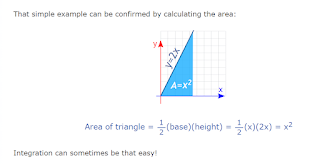The natural logarithm, ln - based on the number e - is the tool
of choice for those working on time and growth problems. Ever
wonder why.
Looking up the e article on the French Wikipedia, I was struck by the
fact that graph below is how the number is actually defined. Not just an
interesting factoid about e but its precise definition. Using the function 1/x:
Had to think this thing out for a while...Did look suspicious e is an irrational
number ( impossible to express as a fraction). Indeed. it is a transcendental number
and cannot be expressed as the root to any equation. (In contrast, the square root
of 2 is irrational but not transcendental because it is a root). It is a never ending
sequence of numbers 2.718281828459045235360...
Now integration in Calculus is used to define an area under a curve. Math is Fun introduces
the notion of integration with this fun illustration:
2.7 1828 1828 45 90 45...



No comments:
Post a Comment